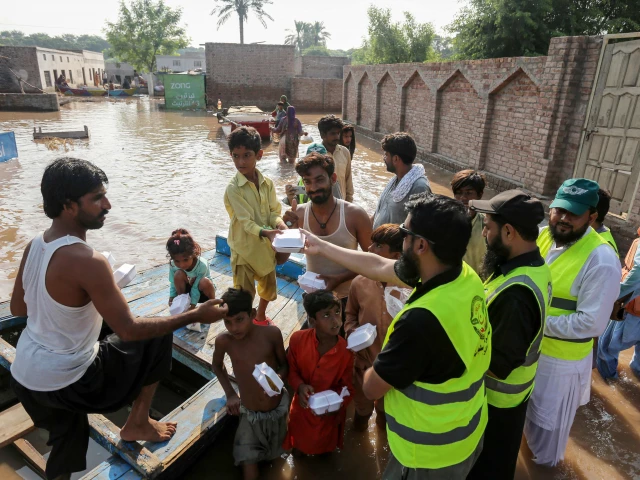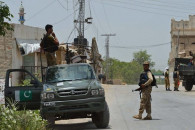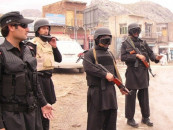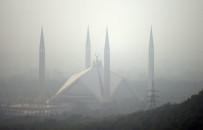Flood levels drop in Sindh, Punjab as relief work continues
Authorities in both provinces stay on alert as forecasts warn of new rain raising river levels

Floodwaters are steadily receding across Sindh’s barrage network, while Punjab reports largely normal river flows, according to provincial monitoring authorities on Tuesday. Relief operations remain in full swing across provinces.
At Guddu and Sukkur, inflows of 611,051 and 571,800 cusecs, respectively, still exceed outflows by 27,900 and 53,680 cusecs, but both points have recorded notable decreases from previous days.
Similar reductions are reported at Kotri and Panjnad.
Read: President Zardari calls for preparedness ahead of heavy rains, flooding in Sindh
Punjab’s Provincial Disaster Management Authority (PDMA) confirmed normal flows in the Indus, Chenab and Ravi rivers, with medium flooding confined to the Sutlej basin and the Panjnad confluence.
At Ganda Singhwala, the Sutlej records a medium flood of 101,000 cusecs, while Head Islam stands at 81,000 cusecs and Sulemanki shows a low flood at 90,000 cusecs.
The Indus continues to flow at manageable levels, with 196,000 cusecs at Tarbela, 169,000 at Kalabagh, 178,000 at Chashma and 161,000 at Taunsa.
Chenab flows remain moderate, ranging from 56,000 cusecs at Marala to 80,000 at Head Trimmu, except for a medium flood surge of 234,000 cusecs at Panjnad.
Read more: Punjab, Sindh brace for 11th monsoon spell
Sindh Senior Minister Sharjeel Inam Memon said the provincial government is fully engaged in rescue and relief efforts, ensuring food, drinking water, medical care and livestock support for those affected.
He reported that 3,522 people were evacuated in the past 24 hours, bringing total relocations to 173,027, with 469 still in relief camps.
He added that 3,192 cattle were moved on Monday, bringing total livestock relocations to 450,571. Veterinary teams vaccinated 39,589 animals in the past day, with an overall total of 1,305,573.
Across Sindh, 183 medical camps are operating, treating 4,174 people in the last 24 hours and 92,958 to date.
Also read: PMD warns of more rains as country reels from devastating floods
Authorities in both provinces remain on high alert as forecasts warn of possible new rainfall that could raise river levels.
Pakistan starts flood damage assessment
Federal Minister for Planning Ahsan Iqbal chaired a meeting of the prime minister’s committee to review the country’s devastating monsoon floods, which began on June 16 and have so far killed nearly 980 people and injured at least 1,176.
Punjab is now seeing waters recede after weeks of inundation, while Sindh remains under strain. Officials said accurate damage estimates will be possible only once floodwaters fully subside, but Iqbal promised a preliminary assessment within ten days. He urged the media to avoid speculation, assuring that verified figures will be shared soon.
The meeting was attended by Finance Minister Muhammad Aurangzeb, the NDMA chairman, the climate change secretary and provincial chief secretaries. Iqbal said rehabilitation efforts are under way, with some 2.5 million displaced and millions of homes rendered uninhabitable in Punjab alone.
International assistance continues to arrive: the United States has dispatched six aid shipments, Britain has pledged £3 million in emergency relief, and Singapore has announced $50,000 in humanitarian aid.
Bilawal Bhutto Zardari has urged further diplomatic outreach and suggested using the Benazir Income Support Programme to deliver cash assistance.
Iqbal and other officials blamed climate change for the scale of the disaster, citing melting glaciers and erratic monsoon patterns.
Climate Change Minister Musadik Malik said his ministry is preparing a 300-day plan to address escalating climate impacts.
Speculation over India’s role was dismissed after experts confirmed that water releases from Indian reservoirs were not deliberate, even though they added to flooding in Pakistan.





















COMMENTS
Comments are moderated and generally will be posted if they are on-topic and not abusive.
For more information, please see our Comments FAQ